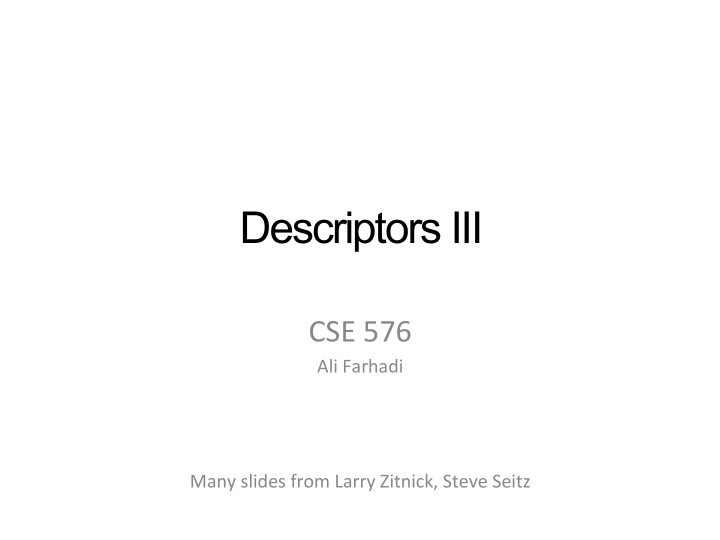



Descriptors III CSE ¡576 ¡ Ali ¡Farhadi ¡ ¡ ¡ ¡ Many ¡slides ¡from ¡Larry ¡Zitnick, ¡Steve ¡Seitz ¡
How can we find corresponding points?
How can we find correspondences?
SIFT descriptor Full version • Divide the 16x16 window into a 4x4 grid of cells (2x2 case shown below) • Compute an orientation histogram for each cell • 16 cells * 8 orientations = 128 dimensional descriptor Adapted from slide by David Lowe
Local Descriptors: Shape Context Count the number of points inside each bin, e.g.: Count = 4 ... Count = 10 Log-polar binning: more precision for nearby points, more flexibility for farther points. Belongie & Malik, ICCV 2001 K. Grauman, B. Leibe
Bag ¡of ¡Words ¡ frequency ¡ ….. ¡ codewords ¡
Another Representation: Filter bank
Spatial pyramid representation • Extension of a bag of features Locally orderless representation at several levels of resolution • level 0 level 1 level 2 Lazebnik, Schmid & Ponce (CVPR 2006)
What about Scenes?
Demo : Rapid image understanding By Aude Oliva Instructions: 9 photographs will be shown for half a second each. Your task is to memorize these pictures
Credit: A. Torralba
Credit: A. Torralba
Credit: A. Torralba
Credit: A. Torralba
Credit: A. Torralba
Credit: A. Torralba
Credit: A. Torralba
Credit: A. Torralba
Credit: A. Torralba
Memory Test Which of the following pictures have you seen ? If you have seen the image clap your hands once If you have not seen the image do nothing Credit: A. Torralba
Have you seen this picture ? Credit: A. Torralba
NO Credit: A. Torralba
Have you seen this picture ? Credit: A. Torralba
NO
Have you seen this picture ?
NO
Have you seen this picture ?
NO Credit: A. Torralba
Have you seen this picture ?
Yes Credit: A. Torralba
Have you seen this picture ? Credit: A. Torralba
NO Credit: A. Torralba
You have seen these pictures You were tested with these pictures
The gist of the scene In a glance, we remember the meaning of an image and its global layout but some objects and details are forgotten
Which are the important elements? Ceiling Ceiling Lamp wall Light painting Painting Door Door mirror mirror Door Door Lamp Wall Wall Door wall wall phone Fireplace alarm Bed armchair armchair Floor Side-table Coffee table carpet Different content (i.e. objects), different spatial layout
Which are the important elements? ceiling ceiling cabinets cabinets ceiling cabinets cabinets wall screen window column window window window window seat seat seat seat seat seat seat seat seat seat seat seat seat seat seat seat seat seat seat seat seat seat seat seat seat seat seat seat seat seat seat seat Similar objects, and similar spatial layout Different lighting, different materials, different “stuff”
Holistic scene representation: Shape of a scene • Finding a low-dimensional “ scene space ” • Clustering by humans • Split images into groups • ignore objects, categories
Spatial envelope properties • Naturalness • natural vs. man-made environments
Spatial envelope properties • Openness • decreases as number of boundary elements increases
Spatial envelope properties • Roughness • size of elements at each spatial scale, related to fractal dimension
Spatial envelope properties • Expansion (man-made environments) • depth gradient of the space
Spatial envelope properties • Ruggedness (natural environments) • deviation of ground relative to horizon
Scene statistics • DFT (energy spectrum) • throw out phase function (represents local properties) • Windowed DFT (spectrogram) • Coarse local information • 8x8 grid for these results
Scene statistics
Scene classification from statistics • Different scene categories have different spectral signatures • Amplitude captures roughness • Orientation captures dominant edges
Scene classification from statistics • Open environments have non-stationary second-order statistics • support surfaces • Closed environments exhibit stationary second-order statistics a) man-made open environments b) urban vertically structured environments c) perspective views of streets d) far view of city-center buildings e) close-up views of urban structures f) natural open environments g) natural closed environments h) mountainous landscapes i) enclosed forests j) close-up views of non-textured scenes
Learning the spatial envelope • Use linear regression to learn • DST (discriminant spectral template) • WDST (windowed discriminant spectral template) • Relate spectral representation to each spatial envelope feature
Learning the spatial envelope • Primacy of Man-made vs. Natural distinction • Linear Discriminant analysis • 93.5% correct classification • Role of spatial information • WDST not much better than DST • Loschky, et al., scene inversion
Learning the spatial envelope • Other properties calculated separately for natural, man-made environments
Spatial envelope and categories • Choose random scene and seven neighbors in scene space • If >= 4 neighbors have same semantic category, image is “ correctly recognized ” • WDST: 92% • DST: 86%
Applications • Depth Estimation (Torralba & Oliva)
Gist descriptor Oliva and Torralba, 2001 8 orientations 4 scales x 16 bins 512 dimensions Similar to SIFT (Lowe 1999) applied to the entire image M. Gorkani, R. Picard, ICPR 1994; Walker, Malik. Vision Research 2004; Vogel et al. 2004; Fei-Fei and Perona, CVPR 2005; S. Lazebnik, et al, CVPR 2006; …
Gist descriptor
Gist descriptor V = {energy at each orientation and scale} = 6 x 4 dimensions 80 features | v t | PCA G Oliva, Torralba. IJCV 2001
Example visual gists Oliva & Torralba (2001)
Features � Where: � Interest points � Corners � Blobs � Grid � Spatial Pyramids � Global � What: (Descriptors) � Sift, HOG � Shape Context � Bag of words � Filter banks
Recommend
More recommend